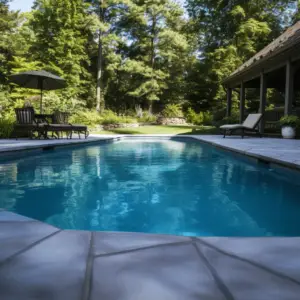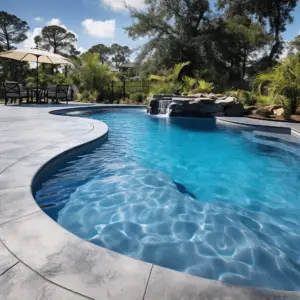Pool Finishes, To keep your pool functioning and looking great all the time, you may need to do some resurfacing. As such, you might be tempted to consider plaster mainly because it’s inexpensive and easy to install. However, while it’s easy on the pocket, pool replastering is associated with several challenges that may make you consider other alternatives.
One negative aspect of plaster is that it lacks durability and you may have to replace it in as little as seven years. Furthermore, plaster doesn’t wear well. It develops cracks and tears easily, which means you’re going to do a lot of repairs often. Fortunately, there are alternatives available that are more stain-resistant, easier to maintain, and last longer.
Table of Contents
Alternative To Replastering A Pool: Suggestions

Fiberglass, stone, pebble, and quartz are probably the most popular alternatives to standard white plaster. Durability, maintenance, appearance, and cost all should be taken into consideration when determining the best alternative for your pool.
Fiberglass
Pool Finishes someone who wants less long-term maintenance, fiberglass is the right option for you. The longevity of fiberglass pool surfaces tends to vary, but they generally provide several intriguing benefits. Fiberglass can last for several decades provided it is installed and maintained properly.
On the lower end of quality, however, the fiberglass pool may need to be refinished about every five years. It is often considered the least expensive alternative to replastering your pool. It is also easier to clean in comparison to standard plaster and offers a lower lifetime cost.
Tiles
Although tiles can be fairly expensive to install in your swimming pool, most experts who work on remodeling often recommend this alternative to regular plaster. In fact, it’s considered to be the best choice in the long term. It gives a premium and aesthetic look to the pool.
That said, however, its high up-front cost often prevents many people from choosing it over regular replastering. A tile surface can last for several decades, making it worth the cost. Both glass and ceramic tiles are almost maintenance-free, with only the occasional cleaning and perhaps re-grouting if necessary.
Tiles don’t require acidic treatment, painting, or even aggressive methods of cleaning that are often required with plastered pools. Tile pool surfaces are also smooth with a vast range of color selections. These pools are also resistant to harsh weather and chemicals.
Pebble and Stone
Swimming pools surfaced with stone and pebbles tend to have a more natural look. This type of finish is basically still plaster, but with various components mixed in. The presence of this combination brings a more stain-resistant and durable finish.
The fact that the stone material is chemically inactive means that this alternative to replastering isn’t likely to react with pool chemicals. In terms of cost, however, a pebble finish can set you back twice as much as the standard white plaster.
It can also be rough than plastering but on the bright side, it can last even more than twenty years, and it blends well with rockscapes or landscape surroundings.
Quartz
Quartz finish is made by blending highly concentrated quartz with white cement. It is a highly durable alternative to replastering and is popular because of its appearance. This type of pool finish can last twelve-fifteen years, which is way much better compared to standard plaster which usually lasts about seven years.
Another major highlight is that quartz is more resistant to changes in chemical conditions. It comes in several colors such as vivid blue hues and subtler colors like beige, which offers a variety of different looks to a swimming pool.
Moreover, the varied surfaces of quartz finishes can hide mineral stains and other blemishes, and give the water a more natural look, just like the ocean.
What’s the Need for Alternatives to Plastering?
While plastering is often considered the most inexpensive option, it will cost you more in the long run. It may seem cheaper and easy to install, but it will last you for only seven years. Pool Finishes is not a durable option in the long run, especially when compared to other alternatives discussed above.
Pools with regular plastering will start to show cracks and tears shortly after being installed. Thus, you may end up spending a lot of money on repairs and maintenance.
Moreover, with pool plaster, you will experience itching and scaling, fading, and delimitation. This will not only ruin the appearance of your pool but will also degrade its overall quality. Plaster lacks the capacity to withstand harsh chemicals typically used in pools either.
So rather than going for a cheap option and paying more money in the end, you may want to consider going for alternatives that offer better benefits and save you money in the long run.
Factors to Consider While Choosing a Pool Finish

Deciding on the best pool finish for your pool can be a big decision, just like any other renovation decision of your home.
Pool Finishes is important to consider both the appearance and the advantages of the pool finish. This includes the budget, weather elements, chemistry of the pool’s water, water temperature, maintenance cost, durability, and personal preferences.
There are some sure signs that show that your pool needs resurfacing. Whether you want to improve the appearance of your pool or you’re just maintaining it, watch out for erosion marks, stubborn stains that cannot be removed, corroded grout, rough areas in the pool, leaking issues, or chalky residue in the pool.
Difference between Resurfacing and Replastering
Both replastering and resurfacing involve working on the interior of the pool. However, replastering basically involves working on the tiles, deck as well as capping around the edge. Even though it’s hardly used in modern days, basic white plaster is the cheapest way to resurface a pool.
